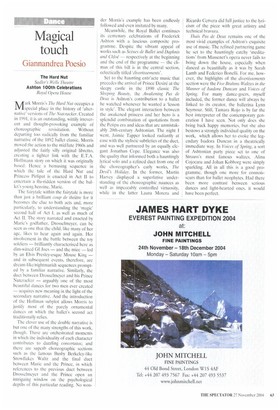Magical touch
Giannandrea Poesio
The Hard Nut Sadler's Wells "Theatre Ashton 100th Celebrations Royal Opera House
Mark Morris's The Hard Nut occupies a special place in the history of 'alternative' versions of The Nutcracker. Created in 1991, it is an outstanding, wittily irreverent and thought-provoking example of
choreographic revisitation. Without departing too radically from the familiar narrative of the 1892 ballet classic, Morris moved the action to the mid/late 1960s and adjusted the fairly silly original libretto, creating a tighter link with the E.T.A. Hoffmann story on which it was originally based. Hence a bemusing sequence in which the tale of the Hard Nut and Princess Pirlipat is enacted in Act II to entertain a flu-ridden version of the ballet's young heroine, Marie.
The fairytale within the fairytale is more than just a brilliant coup de theatre for it becomes the clue to both acts and, more particularly, to understanding the 'magic' second half of Act 1. as well as much of Act II. The story narrated and enacted by Marie's godfather, Drosselmeyer, can be seen as one that the child, like many of her age, likes to hear again and again. Her involvement in the battle between the toy soldiers — brilliantly characterised here as dim-witted GI Joes — and the mice — led by an Elvis Presley-esque Mouse King — and in subsequent events, therefore, are dream-like/nightmarish sequences prompted by a familiar narrative. Similarly, the duct between Drosselmeyer and his Prince Nutcracker — arguably one of the most beautiful dances for two men ever created — acquires new meaning in the light of the secondary narrative. And the introduction of the Hoffman subplot allows Morris to justify most of the purely ornamental dances on which the ballet's second act traditionally relies.
The clever use of the double narrative is but one of the many strengths of this work, though. There are orchestrated moments in which the individuality of each character contributes to dazzling concertatos; and there are superb choreographic sections such as the famous Busby Berkeley-like Snowflakes Waltz and the final duet between Marie and the Prince, in which references to the previous duet between Drosselmeyer and the Prince open an intriguing window on the psychological depths of this particular reading. No won
der Morris's example has been endlessly followed and even imitated by many.
Meanwhile, the Royal Ballet continues its centenary celebrations of Frederick Ashton with a luscious composite programme. Despite the vibrant appeal of works such as Scenes de Ballet and Daphnis and Chloe — respectively at the beginning and the end of the programme — the climax of this bill is in the central section, eclectically titled 'divertissements'.
Set to the haunting entr'acte music that precedes the arrival of Prince Desire at the sleepy castle in the 1890 classic The Sleeping Beauty, the Awakening Pas de Deux is Ashton's contribution to a ballet he watched whenever he wanted a 'lesson in style'. The elegant interaction between the awakened princess and her hero is a splendid combination of quotations from the Petipa era and ideas that arc unmistakably 20th-century Ashtonian. The night I went, Jaimie Tapper looked radiantly at ease with the stylistic subtleties of the duet, and was well partnered by an equally elegant Jonathan Cope, Elegance was also the quality that informed both a hauntingly lyrical solo and a refined duet from one of the choreographer's early works, The Devil's Holiday. In the former, Martin Harvey displayed a superlative understanding of the choreographic nuances as well as impeccably controlled virtuosity, while in the latter Laura Morera and Ricardo Cervera did full justice to the lyricism of the piece with great artistry and technical bravura.
Thais Pas de Deux remains one of the most vivid examples of Ashton's exquisite use of music. The refined partnering game he set to the hauntingly catchy 'meditations' from Massenet's opera never fails to bring down the house, especially when danced as beautifully as it was by Sarah Lamb and Federico Bonelli. For me, however, the highlights of the divertissements section were the Five Brahms Waltzes in the Manner of lsadora Duncan and Voices of Spring. For many dance-goers, myself included, the former dance will always be linked to its creator, the ballerina Lynn Seymour. Still, Tamara Rojo is by far the best interpreter of the contemporary generation I have seen. Not only does she bring back happy memories, but she also bestows a strongly individual quality on the work, which allows her to evoke the legendary Isadora Duncan in a theatrically immediate way. In Voices of Spring, a sort of Ashtonian party piece set to one of Strauss's most famous waltzes, Alina Cojocaru and Johan Kobborg were simply sparkling. All in all this is a good programme, though one more for connoisseurs than for ballet neophytes. Had there been more contrast between serious dances and light-hearted ones, it would have been perfect.


















































































 Previous page
Previous page